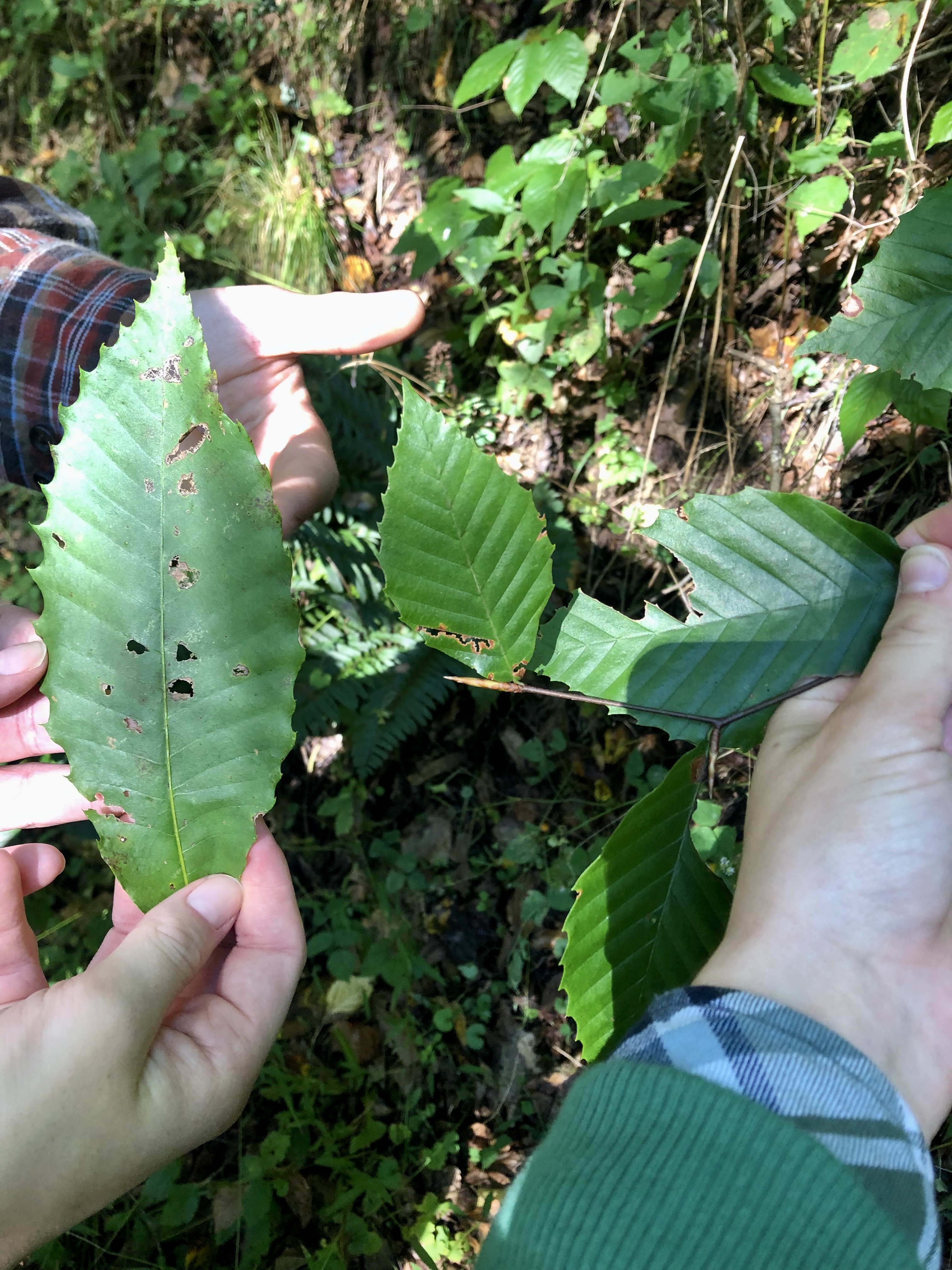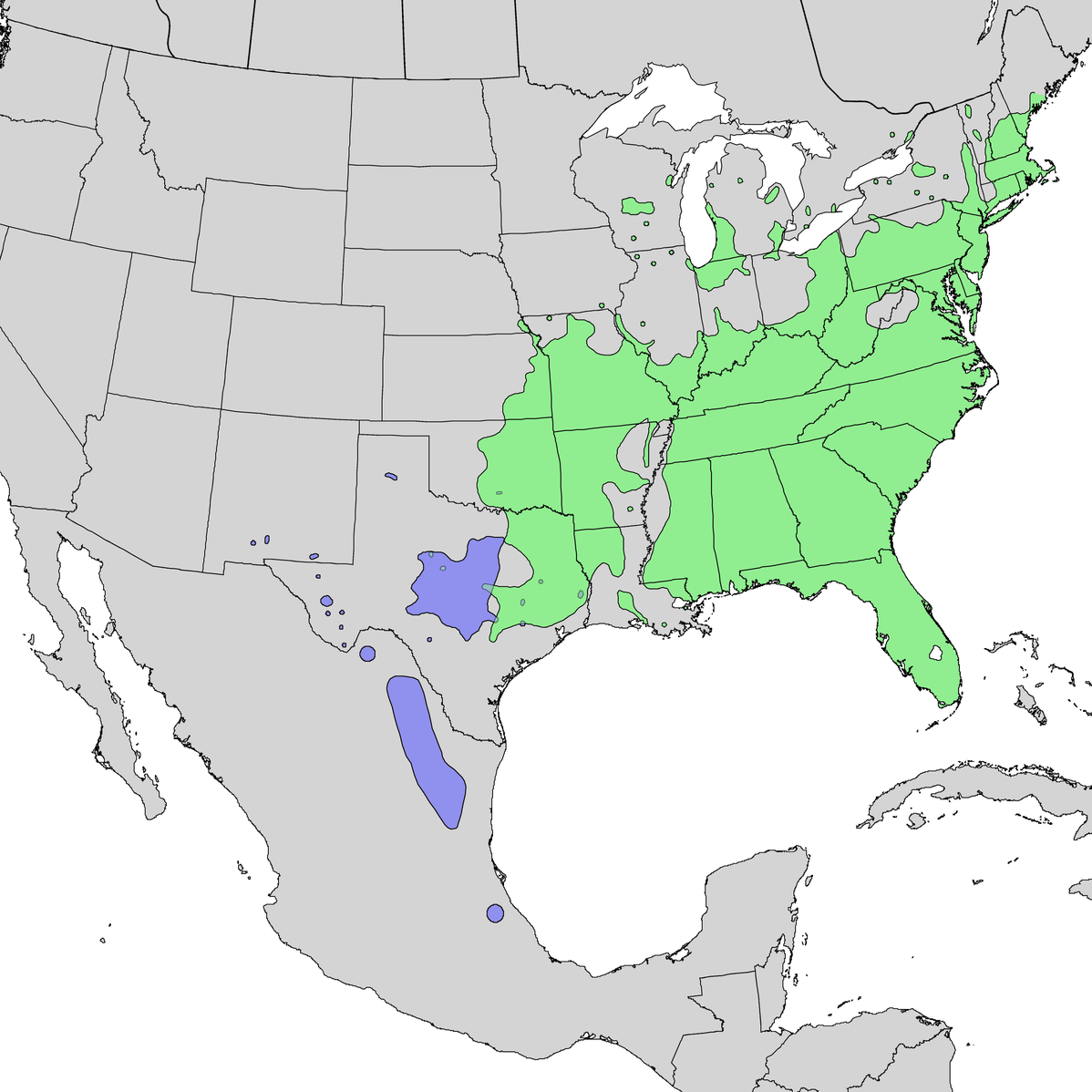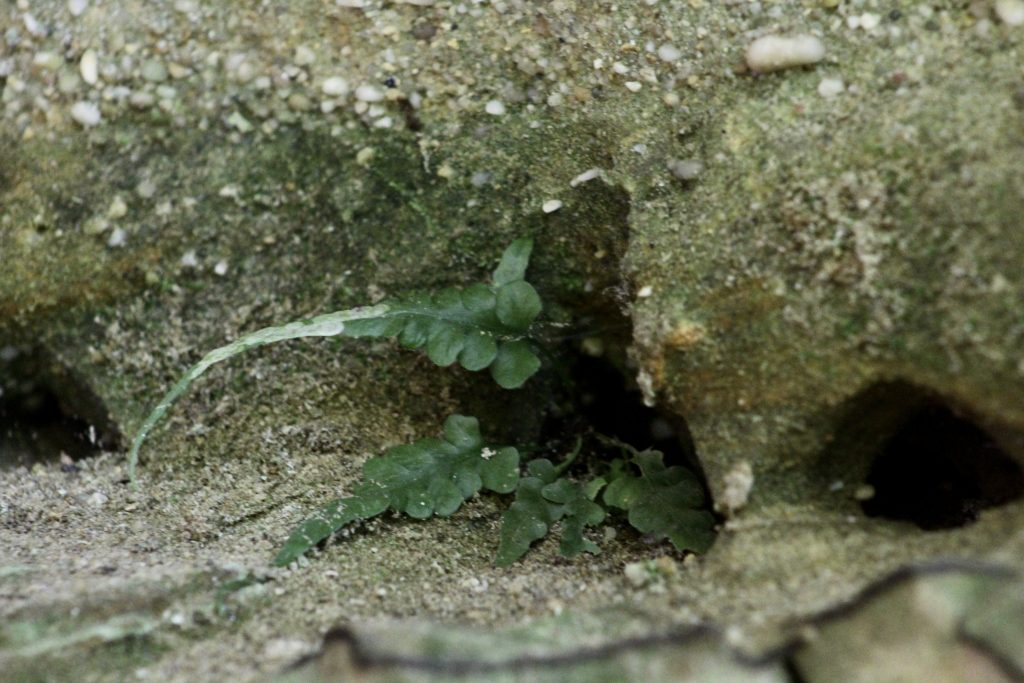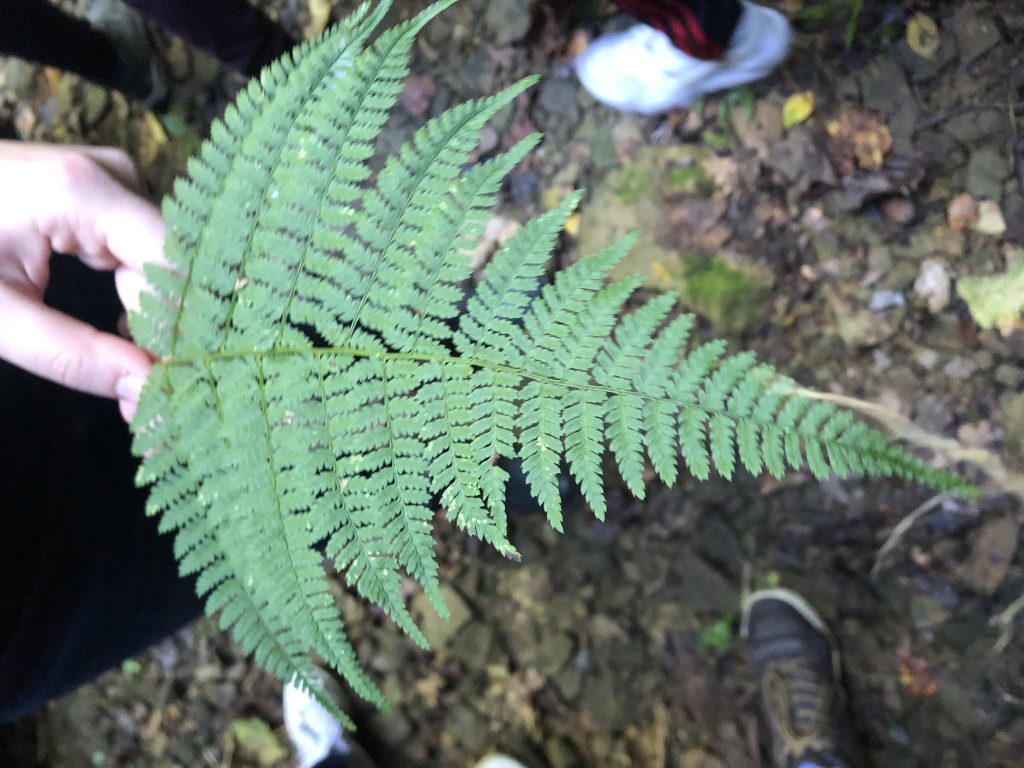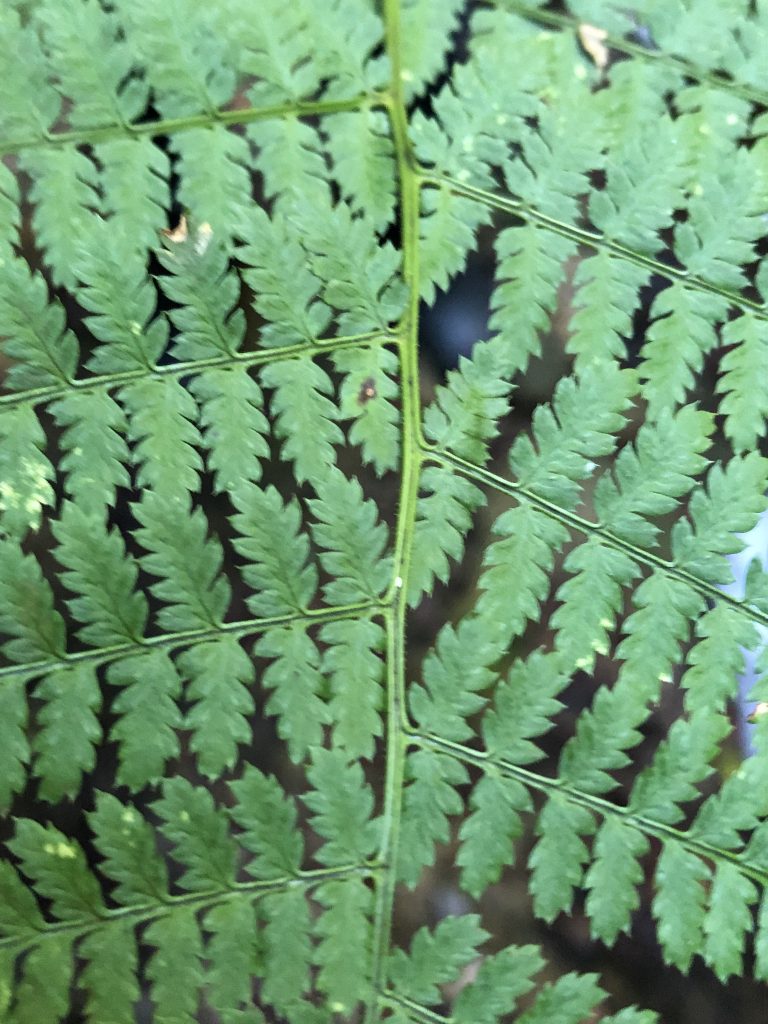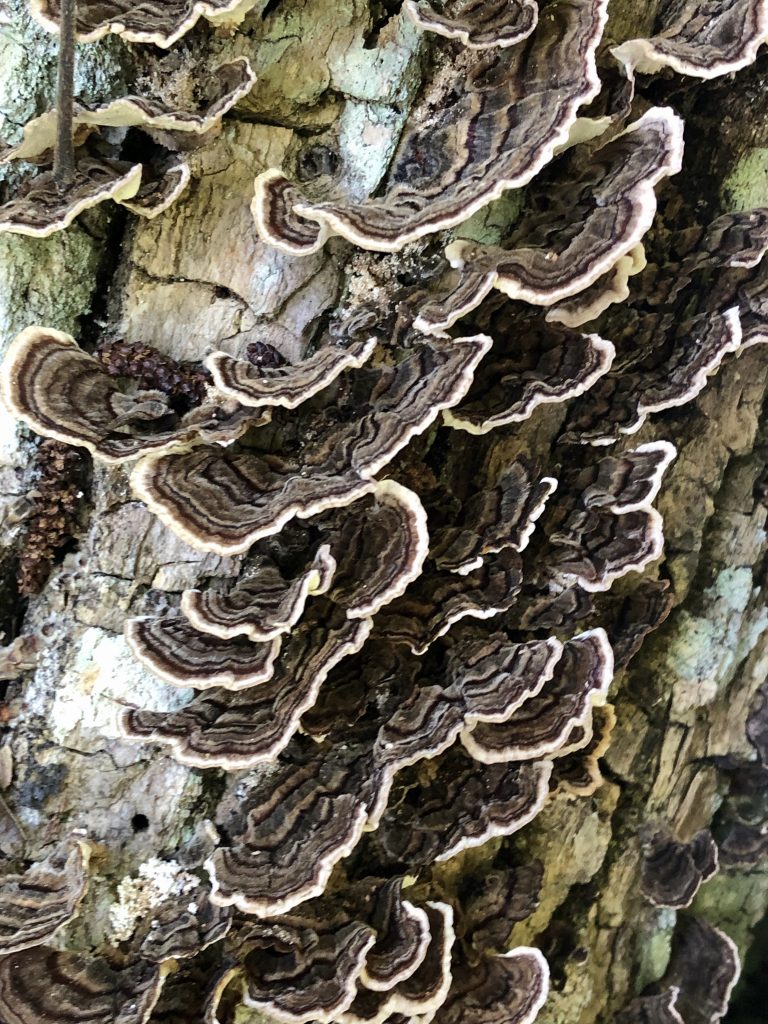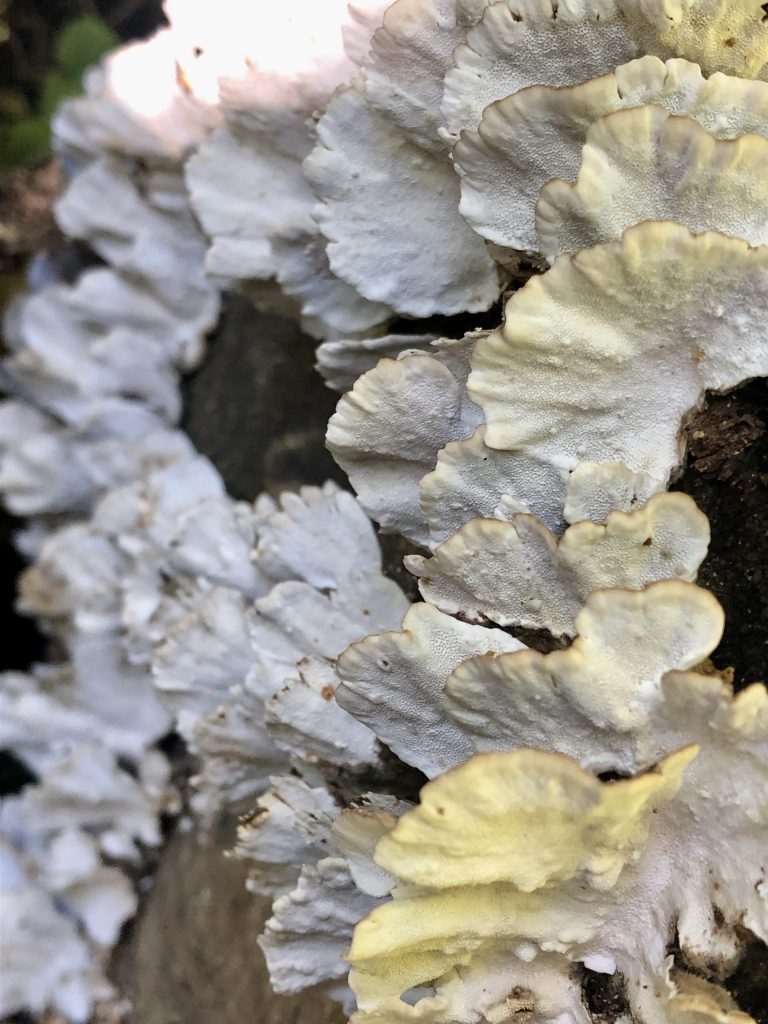Geobotany and Field Trips
Deep Woods Preserve (Hocking Co., Ohio)
Part A: Sandstone Substrate-Associated Plants
Welcome to Geobotany Part II where we will explore the diversity of the southeastern Ohio sandstone substrate! Our class went to a privately owned tract of land east of Laurelville, Ohio, called the Deep Woods Preserve. It is owned and managed by the Blyth family who were nice enough to allow our class to explore some of the awesome plant species there!
The sandstone hills of southeastern Ohio are known for their dry and very acidic substrates. As described in my Geobotany Part I Article, the terrain in southeastern Ohio is quite mountainous (why it is considered part of Appalachia!) and has steep-sided ravines. The plants that prefer a drier substrate would usually be found at the tops of the hills. Some of these plants include the chestnut oak, sourwood, pitch pine, and scrub pine. In the ravines, the climate is moister and cooler which makes it a more suitable location for eastern hemlock.
Our assignment was to discover four species from the Geobotany Article we read by Jane Forsyth, but unfortunately there weren’t too many listed in the article and we happened to not see four of the ones from the list. So, the eastern hemlock and sourwood are from the article and I did some research of my own to discover the range and habits of some of our other southeastern Ohio plant species. See the following images to see what I discovered!
Eastern Hemlock
(Tsuga canadensis)
Our first plant is the eastern hemlock. The hemlock, as stated earlier prefers cooler and moister climates which is why we found it on the sides of the ravines at Deep Woods Preserve. Good ways to recognize the hemlock include a long, slender, white branch with a trunk that is characteristically dark and rough looking. The foliage is also somewhat silvery when viewed from a distance and the needles are soft, short, and numerous along the branches of the tree. The easiest tree to confuse it with would be a fir but there are no firs that naturally occurs in that part of Ohio.
According to Petrides, the hemlock is a poor Christmas tree because it drops its leaves when it dries (occurring when the tree can no longer soak enough moisture in its tree stand!). It also has somewhat low quality wood and avoided the ax. Many virgin growths of the eastern hemlock were eventually cut anyway when humans found a use for the tree in railroad ties. The tree has seeds and needles that are enjoyed by Ruffed Grouse and Sharp-tailed Grouse. Deer, Red Squirrels, hares, and rabbits are appreciate browsing the twigs.
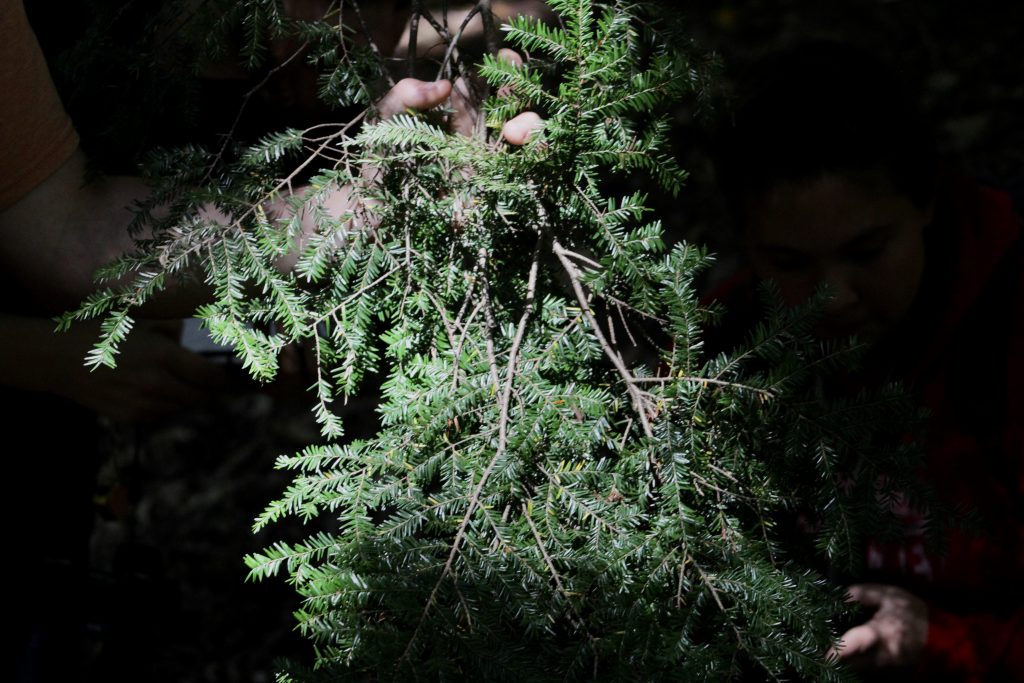
An eastern hemlock branch
Sourwood
(Oxydendrum arboretum)
The sourwood is a type of tree that is found in Petrides under the category, “non evergreen heath with toothed leaves.” I personally didn’t find the leaves to be distinctively toothed until you look very closely at them. Unless you have powerful binoculars or have the leaves in hand this isn’t always a helpful identification tool in my opinion. The sourwood is also the largest tree of its kind with its flowers and fruits arranged in a similar pattern of other ‘heath’ plants. Keep an eye out for the bundle scar as well as it has one! When you crunch up and smell or just take a bite out of the leaves (if you’re Gavin) then they taste quite sour… hence the name!
This tree hasn’t served a specific role in human history, but it has been enjoyed as an ornamental tree since it is nice to look at all times of the year. In nature though its preferred habitat is dry, acidic soils which our higher elevations of sandstone substrate provides for the tree. The tree doesn’t have any particularly notable interactions with animals but the deer do graze the twigs of the sourwood when they are particularly desperate for nutrition in winter months.
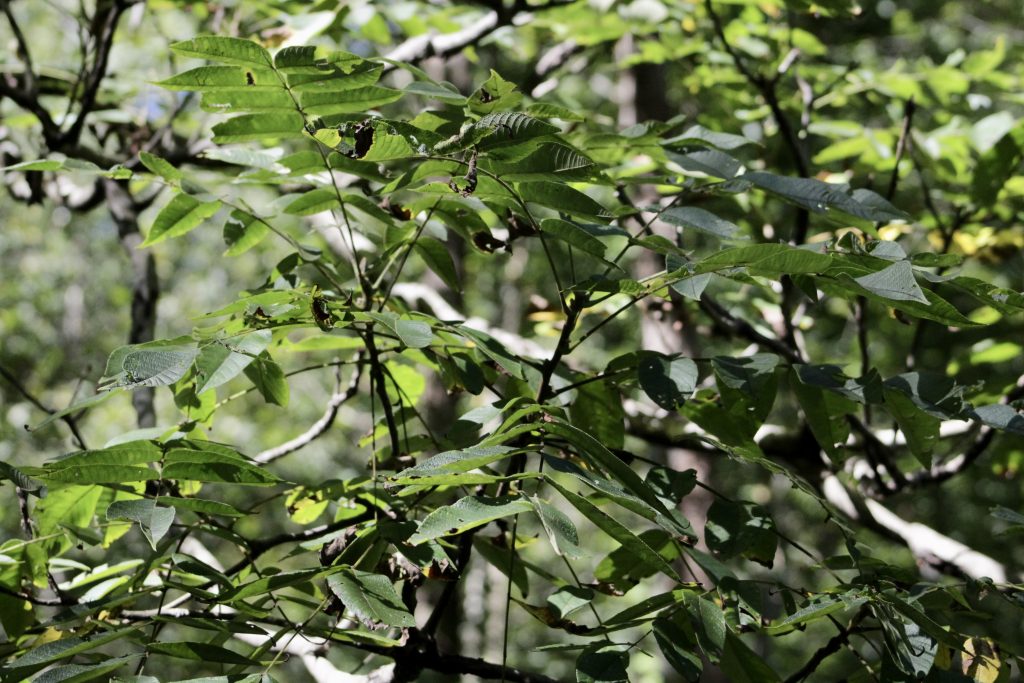
American Chestnut
(Castanea dentata)
The American chestnut used to be an extremely widespread tree across the northeastern United States and Appalachia (see map below), but now its range of healthy trees is highly restricted due to an infestation of disease that got into the population. During the early 20th century, a lethal fungus called the chestnut blight led to the destruction of chestnut trees all across the plant’s range. It is unlikely you would be able to find a healthy tree. Instead, the chestnut tree can be identified from some dead trees still standing or frail regrowth from the base of old stumps.
One can identify the American chestnut through its large leaves that are coarsely toothed (it sort of reminds me of a Chinquapin oak). It also has bluntly shaped buds with are imbricate. The end buds are false and its also has dark brownish twigs. In the photo below you can see how much larger the American chestnut leaf is in comparison to the American beech (Fagus grandifolia) leaf.
- Above you can see the range of the American chestnut before the infestation of the chestnut blight. The source for the map comes from the American Chestnut Foundation.
Back when the chestnut was a dominant tree in our forests, the lumber was quite valuable as it could be used for furniture, musical instruments, house interiors, wooden caskets, and fences (Petrides). It also used to be quite a nutritious food source for mammals and birds including Northern Bobwhite, Wild Turkey, Whitetail deer, and various squirrels.
American Hornbeam
(Carpinus caroliniana)
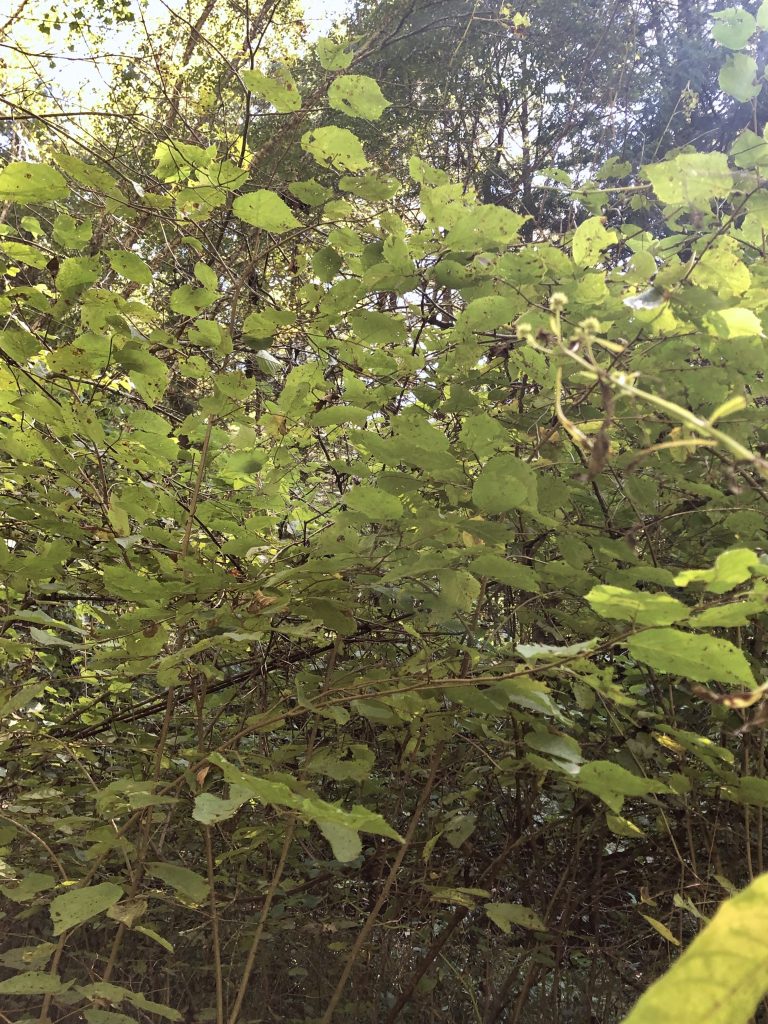 Unfortunately, my phone camera did not want to take good photos of the American hornbeam. That is too bad because it is quite a fine tree! This species is actually called Ironwood in the Petrides guide, but our class knows it as the American hornbeam. I personally know it as Musclewood because a key identification feature is that its trunk feels and is shaped like that of a flexed muscle.
Unfortunately, my phone camera did not want to take good photos of the American hornbeam. That is too bad because it is quite a fine tree! This species is actually called Ironwood in the Petrides guide, but our class knows it as the American hornbeam. I personally know it as Musclewood because a key identification feature is that its trunk feels and is shaped like that of a flexed muscle.
Despite not being on Jane Forsyth’s list of trees, it is considered an acidophile and prefers substrates that provide that, like our sandstone substrate! Other characteristics of the American hornbeam include double serrated leaves and distinctive catkin fruit can be seen on the tree as well except for the winter months. The end buds are also false and other beds often appear square if you were to take a cross-section of them.
A cool fact about this true is that the charcoal created from the wood used to be used as a gunpowder! The fruits are also eaten by a variety of animals including pheasants and gray squirrels.
Winged Sumac
(Rhus copallinum)
The Winged Sumac is another wonderful, native, gorgeous shrub! It’s range is the eastern portion of the United States (see below) and it prefers upland habitats with somewhat acidic soils. This explains why we found it at the top of a hill at the Deep Woods Preserve! It doesn’t specifically like sandstone but the substrate provides the acidity and habitat that is most accommodating for the plant. The most characteristic feature of this sumac is the ‘wings’ (hence the name) on the twig of the shrub. You can see the small winged lobes on the branch in the photo below. It is also turning a gorgeous red color as it looses its chlorophyll… gorgeous!
One interesting fact about the sumac is that animals can actually eat its bark! It is a good food source for Fox Squirrels and Cottontail rabbits in the winter months. It is another one of our shrubs that is often planted for its ornamental value. I can’t help but wonder if its because how lovely they look during the fall months.
- In this map you can see the natural range of the Winged Sumac. It mainly prefers the acidic soils wherever it can find them which is why it mainly occurs only in the eastern part of Ohio. The source from this photo is the Wikipedia Commons of Rhus copallinum.
Part B: Biotic Threats to Forest Health
On our class plant walk, we talked about two important examples of biotic threats to the health of the forest ecosystem. These biotic threats effect two species: the American chestnut and the butternut. Both have resulted in the damage of two forest species that were a staple of the forest ecosystem. Without these species there is a loss of biodiversity of those species and other species that rely on the tree species for food and protection.
First, the American chestnut, Castanea dentata, actually has an entire website devoted to its history that was created by the American Chestnut Foundation (ACF). The American chestnut was once a dominant tree species in our eastern United States forests and was often used by humans for log cabins, poles, posts, and railroad ties. Their edible nuts also provided a food sourdoughs to livestock and it was also enjoyed by people during the holidays.
Unfortunately, at the turn of the century the agent for the chestnut blight was introduced into the United States population of chestnuts from what is thought to be a blight fungus parasite originating from Asia called Cryphonectria parasitica. The blight attacks the tree by creating cankers on it that girdle branches and the trunks. It effectively kills the top part of the tree only leaving roots to attempt to sprout and then die off again. There has been no cure found for infected trees with this disease but efforts have been made to breed the Chinese chestnut with the disease-resistant Chinese chestnut. This project has mainly found to be a failure though. One could also think of the ethics of breeding such trees since technically they aren’t pure American chestnuts and may not fill the same ecological niche when reintroduced into the habitat. The few places where American chestnuts are uninfected are highly quarantined and when the disease is found scientists do their best to eradicate it. It appears to be only a matter of time though before the disease fully progresses. Poor chestnuts! I hope we find a better management solution in the future.
The Butternut, Juglans cinerea, is a type of walnut that is also affected by a fungal disease that is called the butternut canker. The agent is thought to come from outside the United States. Again, this disease girdles the branches and trunk of the tree which cuts off nutrient and water flow to all parts of the tree after the location of the canker. Once the canker gets to the trunk the disease is usually fatal, but it can be managed by cutting off the infected branches if founds early so the diseased parts don’t spread. Unfortunately, cutting off parts of the tree can only just create more access points for the fungus. The name of this strange fungus that causes the disease is Sirococcus calvigignentijunglandacearum. What a long name!
There isn’t a known cure for the trees that have trunk butternut canker, but not all butternut trees have contracted the disease from the fungus. Some do not get the disease in a place that causes death and they may have at least a degree of resistance to the fungus. The best bet for the future of the butternut (also known as white walnut!) may be to breed and observe the resistant trees to potentially rebuild the population with the ability to resist the disease.
Part C: The Appalachian Gametophyte
Talk about an amazing specialist plant! Enter the Appalachian gametophyte, Vittaria appalachiana. It may not look it, but this strange specimen is actually a fern and is in the Phylum Pteridophyta. This fern is extremely unique in that it is the only one of its kind to exist primarily in the gametophyte stage of the fern life cycle. In comparison, other fern species exist mainly in the sporophyte (frond-like) part of their life cycle.
I had the chance to learn even more about the Appalachian Gametophyte life cycle from some great resources including this excerpt from the “Flora of West Virginia” and another article from the American Journal of Botany called “Unraveling the Origin of the Appalachian Gametophyte.” Read these to gain a better understanding of the gametophyte or read on for my own summary below.
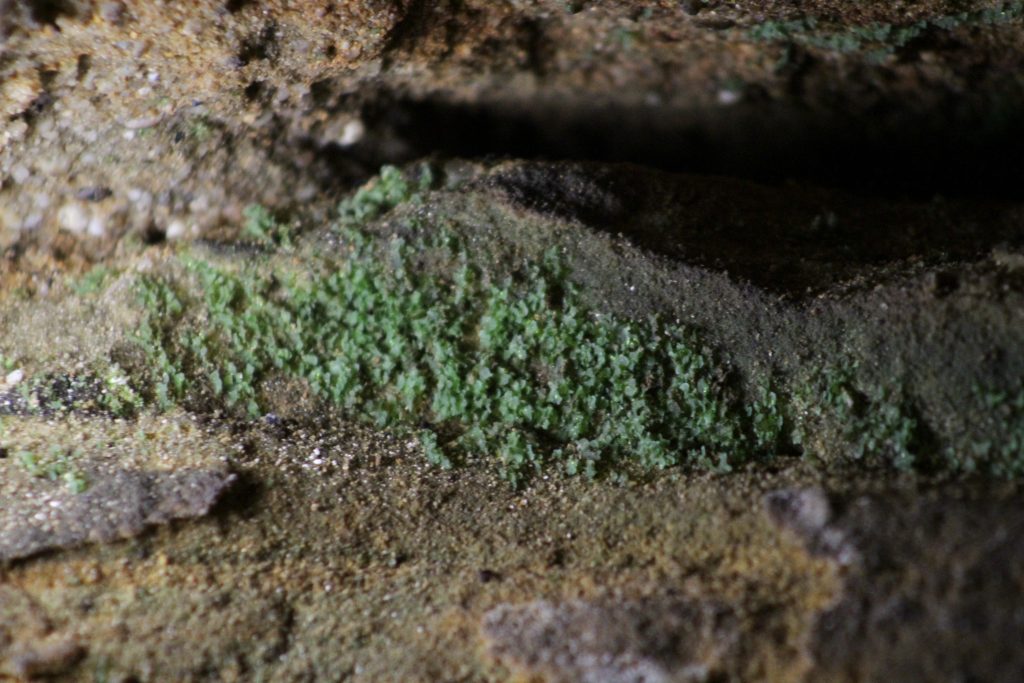
The Appalachian Gametophyte nestled in the ledge of a cave at the Deep Woods Preserve.
These long-lived gametophytes like all plants participate in the alternation of life cycles which they spend a portion of their life as haploid gametophytes and another part of their life as diploid sporophytes. The Appalachian gametophyte decides to spend the majority of its life that way. This plant’s range is restricted to the Appalachian Mountains and eastern United States plateau. It prefers outcrops, like the cave we found it in, where it can grow next to water. The plant exists exclusively as a vegetative gametophyte and is one of three fern species discovered in the world where the mature version of the sporophyte (fern fronds) have never been observed.
These ferns reproduce asexually through gemmae that are much larger than the spores that other ferns use to reproduce. The gemmae are approximately 0.2-1.0mm in length! This is too large for wind dispersal. Three theories have been brought up by scientists on the dispersion of the gemmae via methods including short distance wind dispersal, water dispersal, and dispersal by other animal species. According to Kimmerer and Young (1995), there has been shown to be dispersal in some bryophytes that is aided by slugs. In other paper by Rudolphi (2009), there has been shown to be aid by ants over short distances! There appears to be much evidence that animals are key in the dispersal of the Appalachian Gametophyte gemmae.
There is evidence for limited dispersal capability for the Appalachian gametophyte because this species is notably absent north of the extent of the last glacial boundary. Even when these species are transplanted north of the boundary they do not survive well. Even in areas that would appear to be good habitat, such as recently disturbed areas like roads and tunnels, the gametophyte does not persist while other species thrive. It would appear that even though this species can’t distribute itself now, it used to be able to sometime before the last ice age. The plant lost its ability to produce mature and functioning sporophytes which were responsible for the wide range of Appalachia that the plant current covers. Without it using sporophytes sometime in its history, it would not have been able to spread so far.
Based on the evidence I have read and the background I’ve gained on the Appalachian Gametophyte, I do not think that the current populations of this species could be supported by long-distance dispersal by some tropical sporophyte source. The truncated range of V. appalachiana in the southern part of New York goes to show that the distribution would be solely due to spore dispersal since the sporophyte went extinct. It is unable to extend northward so it is not capable of any form of long-distance dispersal. Allozyme studies on the species allow for further genetic understanding which also support this reasoning.
In the photo above, you can observe another type of fern, the Walking Fern! The Walking fern has a scientific name of Asplenium rhizophyllum and as typical of the fern phylum, it is a seedless, vascular plant. This plant is most certainly not an Appalachian gametophyte as it exists primarily in the sporophyte stage of the fern life cycle like other fern species do. This fern plant was hanging out in the same cave in vicinity to the Appalachian Gametophyte! I wonder if the neighbors realize just how closely related they are…
Part D: Ferns, Ferns, Ferns! And More!
Heather, our lovely TA, also assigned us students some additional scavenger hunt assignments! My task was to find a couple additional fern species. I could barely decide which ones to include since I have so many but in the end I included some of my favorites…
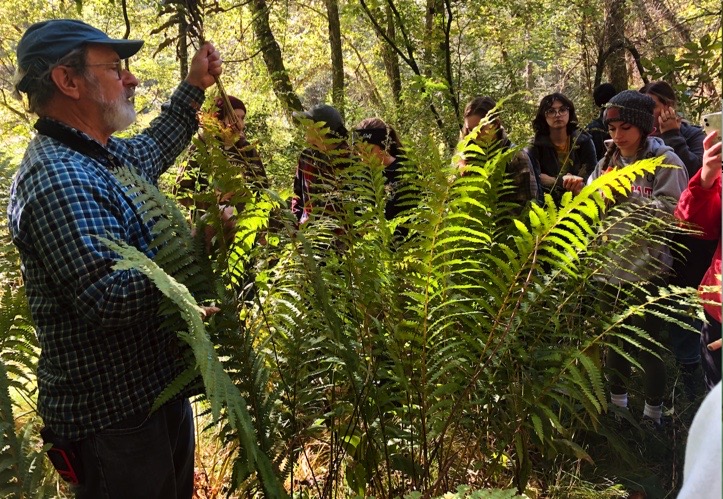
First, we have the knowledgeable, pun-master Dr. Klips presenting on this Cinnamon Fern! The Cinnamon Fern has a scientific name of Osmunda cinnamomea and is known for its large size! The only larger fern that I know of is the Ostrich fern which can get over five feet tall (taller than me even!). Cinnamon ferns, even though I have never seen them this height, can also apparently grow up to six feet! This fern is what we would call holodimorphic fern species. Holodimorphic means that some of the fronds produced are infertile and simply vegetative while others are devoted to spore production and are known as fertile fronds. Usually the fertile fronds are dark brown and a single stalk while the infertile fronds green vegetation with typically many lobes.
Helpful identification of this fern can be looking at the infertile fronds to see how the frond’s leaves are divided. The frond dissection type of the Cinnamon Fern is pinnate-pinnafid. This means that the leaves split once and then also split again somewhat to form lobes on top of the lobes (I found that thinking of it like a fractal is helpful). The genus Osmunda is also known for enjoying swampy and wet woods and it tends to grow together in large clumps of infertile fronds.
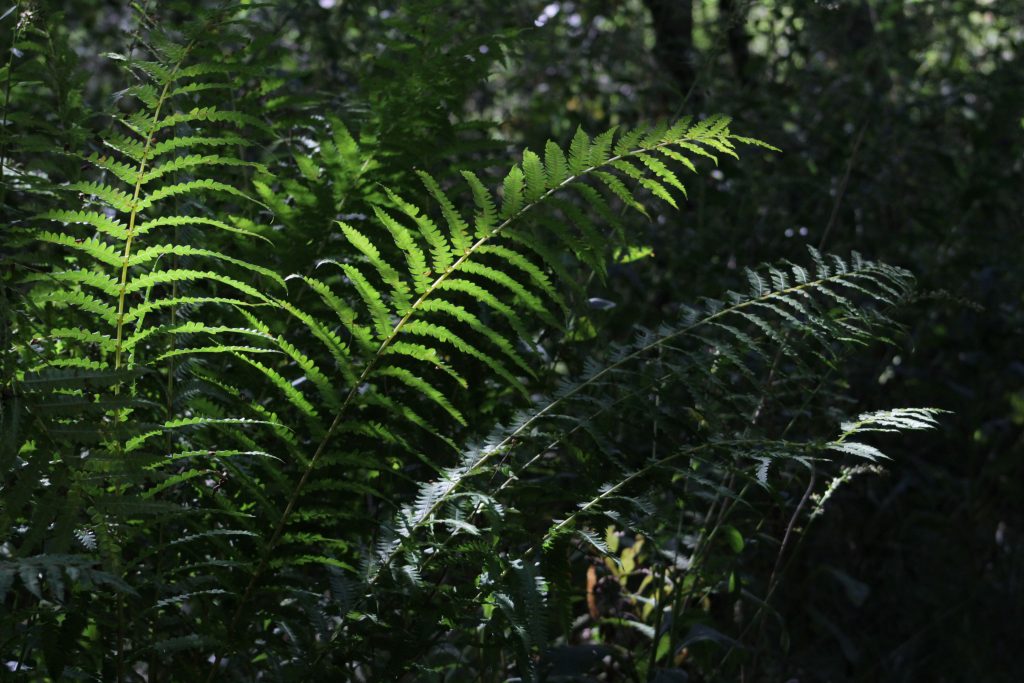
Another photo of the Cinnamon Fern, the largest fern species we saw on our field trip.
Another cool fern species is the Royal Fern, Osmunda regalis. This fern can be identified as bipinnate since it has individually pinnae (infertile frond leaves) that are further fully divided into pinnule. The pinnule are also pinnate unlike the Cinnamon fern where they are pinnafid meaning the base of the lobes are attached to one another (not fully divided). This plant is also an example of a hemidimorphic frond dissection type. This means that the individual fronds are divided into a fertile section and an infertile section. The bottom portion of the frond contains the vegetative pinnae while the top has the fertile pinnae that produce spores.
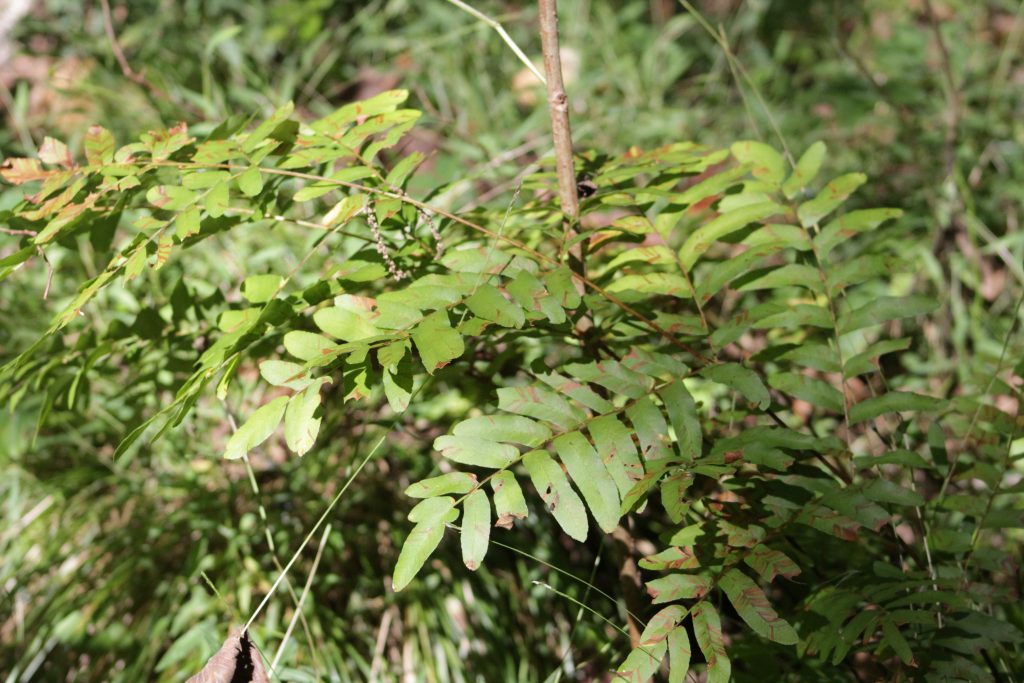
Royal fern (Osmunda regalis) showing infertile part of the frond.
Finally we have a third fern called the Spinulose Wood Fern (Dryopteris carthusiana). It is unique compared to the other Osmunda ferns because instead of being pinnate-pinnafid or twice compound this fern species is three times compound! It is also another type of frond dissection called monomorphic which means that the spore producing structures are on the vegetative part of the plant making all the fronds fertile fronds. Unfortunately you don’t see any sori in the photos below but they would be located on the underside of the fronds. This plant also has a reniform indusium type. The unequal sided lower pinnae are diagnostic of this species.
After a long day of hiking and looking at plants, I was very satisfied with my documentation of many fern, moss, and trees species I had never seen before! With every plant adventure I go on, I realize just how fascinating the outdoors is and how many amazing questions are still left to be answered about nature… I can’t wait for my next discovery!
- Some totally awesome fungi I don’t know the name of! Thanks for reading 🙂


